Written by: Tim Linehan, Linehan Outfitting Co.
The high water of spring is not the time to take chances or to learn the ropes.
Photo by Phil Monahan
A few years ago, toward the end of March, I watched as three guys in a 14-foot raft floated by me, spinning in uncontrollable circles, on Montana’s Bitterroot River.
“That’s not good,” my client, Alan, said with a grimace.
“That’s the understatement of the day,” his partner, Larry, said from the back of the boat.
About a half mile downstream, we passed the raft, and it looked like the guys oaring it had made some progress. At least the raft was facing downstream.
Around the bend, I pulled hard on the oars, slipped the stern of the boat across the current and slid into a big eddy near the bank that always holds fish in the spring. Just as the boat settled and I was getting ready to tell my clients to make a few casts to the head of the current, I noticed a cooler floating by in the middle of the river.
“What the hell is that?” Alan said from the front of the boat.
“It’s a cooler, and here comes the rest of the gear from that raft,” I replied.
Sure enough, fly boxes, oars, life jackets, and everything else from the raft went floating by. Obviously, the three guys in the raft had flipped it and were in a world of trouble.

Being prepared for what’s around the bend is vital for safe boating.
Photo by Phil Monahan
Spring fishing trips can be very rewarding and very fun. But early season conditions can also mean very cold, high water, and depending on the river, challenging oaring situations. Safe boating is easily accomplished by keeping these clear, hard rules in mind.
1. Know your limitations.
If you have little or no experience oaring a craft in moving water, don’t plan on learning during the early-spring fishing season when conditions are potentially the most difficult.
2. Do your homework.
Spring runoff can bring debris, hang sweepers across channels, stage root wads just below the surface, and literally change the entire course of the main stem of rivers. Before you do a float, do your homework. Research the stretch by talking to local fly shops, local anglers, and talk specifically to other people at the boat ramp. If you don’t know the stretch is clean, don’t float it and choose another stretch.
3. Wear a life jacket.
Life jackets are uncomfortable, but they save lives. If you’re not a strong swimmer or plan on running some challenging water, wear a life jacket.
4. Prepare a dry bag.
Spring fishing conditions can bring severe weather. Be prepared by packing extra clothes in a dry bag and by dressing in layers.
5. Don’t be a hero.
Even if you have many years of experience on the sticks, don’t shoot the rapids if you feel even the slightest bit of hesitation. Go around, rope your boat through, or let your partner with more experience take the oars.
6. Set up your line early.
During spring fishing conditions and high, fast water, it’s imperative to set up your line early. Be diligent about looking downstream and anticipating upcoming situations. With faster water, plan your line much farther away from, say, the cottonwood sweeper hanging ten feet off the bank. Pull hard and early, and get off the bank well in advance of the tree.
***
“Oh my god…are those a pair of waders, or am I seeing what I think I’m seeing? I heard Larry groan.
Sure enough, the situation was as tragic as we all thought. And there was nothing we could do, as the lifeless victim floated by two hundred yards away in the main current. Fortunately, his two partners had been able to swim ashore to safety. Needless to say, everyone’s world turned upside down that day.
Spring fishing can be terrific. But spring boating and floating conditions can be challenging and often even dangerous if you’re unprepared or inexperienced. By being safe, rather than sorry, and by being smart, you can avoid dangerous situations and avoid having your world turned upside down.
Tim Linehan is the owner of Linehan Outfitting Co. on the Kootenai River in Troy, Montana. He’s also a former Trout Bum of the Week.
Credit: Source link































